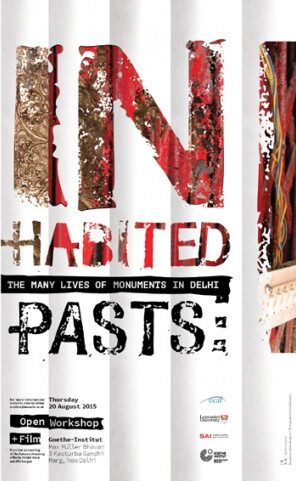ECAF Fellowship report from Dr. Deborah Sutton, Senior Lecturer in History, Lancaster University
ECAF Centre: Heidelberg University, Branch Office New Delhi
The research carried out in Delhi was extremely productive but did deviate from the course anticipated in my application. The Superintendent of the Delhi Archaeological Circle had changed and the new Superintendent, while quite communicative, was not as facilitative as I had hoped. Most of the work done, therefore, was carried out at the sites of registered monuments in Delhi and at the Delhi State Archives.
The highlight of the research was a workshop held at the Goethe Institute, at the Max Muller Bhavan.
The workshop attracted six excellent presentations and included the preview screening of a short film, ‘The Palace Is Dreaming’ a film by Parijat Desai and Alla Kovgan. The film was discussed by Professor Kavita Singh of the School of Art and Aesthetics at JNU. The workshop attracted a large audience (31) and paper summaries were invited for consideration for publication in Frontline, India’s premier weekly news magazine.
I was able to carry out a comprehensive survey of inhabitation and perceived delinquency at registered monuments in the city before independence. The dissonance between bureaucratic intent, and the enactment of legislation, and the department’s ability to know, let alone control, the local use of registered monuments was striking. The department of archaeology accommodated a range of usages, in particular at Muslim religious sites, but then faltered in its attempts to monitor permitted customary usage or maintain records of the nature of the allowances made. Despite this, the department appears to have begun, and continued, to measure appropriate custody according to the care and condition of the monument, not according to the letter of protection legislation. It became clear that archaeological custody in the 1920s and 1930s gave greater latitude to devotional activity that in the post-independent period. From the 1970s onwards, and today, site usage has been informally accommodated by superintendents and chowkidars.
The occupation of monuments and their position within the rapidly developing city has not been a linear process of loss. I was able to consult voluminous records that dealt with the occupation, planned and unplanned, and evacuation of mosques in the city following the partition in 1947. These files contain fascinating information about two registers of history; the agreements brokered between India and Pakistan (which emphasised a commitment to preserve sacred sites abandoned by the displaced on both sides) and the contingent need to provide some form of shelter to refugees. Hundreds of buildings were occupied by refugees and the majority were gradually evacuated (refugees repeatedly sought alternative accommodation). The occupation of registered monuments in the city, the Purana Qila, Safdarjung’s tomb, Humayaun’s tomb and Ferozshah Kotla, represents a neglected history of the city’s past.
I will return to Delhi in January/February for two weeks and deliver papers at Jawaharlal Nehru University and Nehru Museum. In hope soon after to submit an article for publication, provisionally entitled, ‘Inhabited Pasts: Monuments, Protection and Publics in New Delhi, 1912 – 1970s’, for publication in the Indian Economic and Social History Review.

